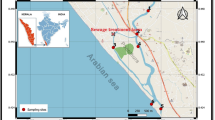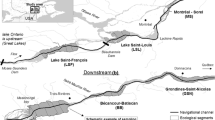Abstract
The construction of an estuary barrage, an instream structure in the lower reaches of a river, causes significant physical changes in water flow patterns and river morphology, and results in altered environmental conditions. Here, we examined the impact of the Geum River estuary barrage, completed in 1990, on fish assemblages by using a literature search and fresh surveys of fishways in the barrage. We found that fish assemblages upstream and downstream of the barrage were altered following its completion. After construction, more species were found in the freshwater area, with a particularly great increase in freshwater species. Conversely, estuarine and marine species were only consistently caught in the downstream salt-water area, although the number of species increased. In total, 15,829 fish from 47 species and 20 families were identified at the three types (pool and weir, rubble type, and boat passage) of fishways in the barrage. The dominant species were Chelon haematocheilus, an estuarine species, Coilia nasus, a diadromous species, and Erythroculter erythropterus, a freshwater species. The mean total length of fish (101.9 ± 76.0 mm) in the boat passage fishway was approximately 100 mm lesser than those in the pool and weir (207.2 ± 112.8 mm) and rubble type (205.8 ± 112.7 mm) fishways. The boat passage fishway was the most efficient for fish movements. The current fishway system is not sufficient for fish migration, and thus additional ways are required to improve the system such as the boat passage. Few estuarine or diadromous species were found in both freshwater and salt-water areas, but freshwater fishes that accidently moved to salt-water area actively used fishways. Therefore, fishway management in the Geum River estuary barrage has to focus on freshwater fish; however, this may need to change to a focus on migratory fishes depending on ecological life cycles of migratory fish.
Similar content being viewed by others
References
Amisah S, Cowx IG (2000) Response of the fish populations of the River Don in South Yorkshire to water quality and habitat improvements. Environ Pollut 108:191–199
An KG, Hong YP, Kim JK, Choi SS (1992) Studies on zonation and community analysis of freshwater fish in Kum-river. Korean J Limnol 25:99–112
Anderson MJ, Gorley RN, Clarke KR (2008) PERMANOVA+ for PRIMER: guide to software and statistical methods. PRIMER-E, Plymouth, 214 p
Barletta M, Barletta-Bergan A, Saint-Paul U, Hubold G (2005) The role of salinity in structuring the fish assemblages in a tropical estuary. J Fish Biol 66:45–72
Billman EJ, Pyron M (2005) Evolution of form and function: morphology and swimming performance in North American minnows. J Freshwater Ecol 20:221–232
Blaber SJM, Brewer DT, Salini JP (1995) Fish communities and the nursery role of the shallow inshore waters of a tropical bay in the Gulf of Carpentaria, Australia. Estuar Coast Shelf S 40:177–193
Branco P, Santos JM, Katopodis C, Pinheiro A, Ferreira MT (2013) Effect of flow regime hydraulics on passage performance of Iberian chub (Squalius pyrenaicus) (Günther, 1868) in an experimental pool-and-weir fishway. Hydrobiologia 714:145–154
Bunt CM, Castro-Santos T, Haro A (2012) Performance of fish passage structures at upstream barriers to migration. River Res Appl 28:457–478
Burt TN, Cruickshank IC, Littlewood MA (1999) Towards developing guidelines for assessment, design and operation of estuarine barrages. In: Vollmer M, Grann H (eds) Large-scale constructions in coastal environments. Springer, Heidelberg, pp 35–54
Chen WB, Liu WC, Huang LT (2013) The influences of weir construction on salt water intrusion and water quality in a tidal estuary—assessment with modeling study. Environ Monit Assess 185:8169–8184
Choi KC, Lee JY, Kim TR (1977) Survey on the fish fauna in Geum River around Dae-Dhung dam in construction - The list of fishes and their distribution. Korean J Limnol 10:25–32
Clarke KR, Warwick WM (1994) Similarity-based testing for community pattern: The 2-way layout with no replication. Mar Biol 118: 167–176
Clay CH (1995) Design of fishways and other fish facilities. CRC press, Boca Raton, 248 p
Costa MJ, Bruxelas A (1989) The structure of fish communities in the Tagus Estuary, Portugal, and its role as a nursery for commercial fish species. Sci Mar 53:561–566
Dugan PJ, Barlow C, Agostinho AA, Baran E, Cada GF, Chen D, Marmulla G (2010) Fish migration, dams, and loss of ecosystem services in the Mekong basin. Ambio 39:344–348
Eklov A, Greenberg L, Bronmark C, Larsson P, Berglund O (2002) Response of stream fish to improved water quality: A comparison between the 1960s and 1990s. Freshwater Biol 40:771–782
Elliott M, Dewailly F (1995) The structure and components of European estuarine fish assemblages. Neth J Aquat Ecol 29:397–417
Field JG, Clarke KR, Warwick M (1982) A practical strategy for analyzing multi-species distribution patterns. Mar Ecol-Prog Ser 8:37–53
GRERC (2012) Survey of lake environment and ecology in the Geum River system. Geum-River Environment Research Center (GRERC), National Environmental Research Institute, Incheon, 394 p
Gibson RN (2003) Go with the flow: tidal migration in marine animals. In: Jones MB, Ingólfsson A, Ólafsson E, Helgason GV, Gunnarsson K, Svavarsson J (eds) Migrations and dispersal of marine organisms. Springer Netherlands, pp 153–161
Gosset C, Travade F, Durif C, Rives J, Elie P (2005) Tests of two types of bypass for downstream migration of eels at a small hydroelectric power plant. River Res Appl 21:1095–1105
Hall CJ, Jordaan A, Frisk MG (2011) The historic influence of dams on diadromous fish habitat with a focus on river herring and hydrologic longitudinal connectivity. Landscape Ecol 26:95–107
Hatry C, Binder TR, Thiem JD, Hasler CT, Smokorowski KE, Clarke KD, Cooke SJ (2013) The status of fishways in Canada: trends identified using the national CanFishPass database. Rev Fish Biol Fisher 23:271–281
Helms BS, Hartfield EE, Werneke DC, Feminella JW, Gangloff MM (2011) The influence of low-head dams on fish assemblages in streams across Alabama. J N Am Benthol Soc 30:1095–1106
Hwang GH, Jeon SR, Kim MO, Hoang CS (1992) Fish fauna of the lower area of Kum-river. J Basic Sci 6:53–74
Hwang WH, Hwang HB, Noh HS, Lee TW (2005) Seasonal variation in species composition of fish collected by a bag net in the Geum River Estuary, Korea. J Korean Fish Soc 38:39–54
Jowett IG, Richardson J (1996) Distribution and abundance of freshwater fish in New Zealand rivers. New Zeal J Mar Fresh 30:239–255
Kim IS, Choi Y, Lee CL, Lee YJ, Kim BJ, Kim JH (2005) Illustrated book of Korean fishes. Kyohak publishing, Seoul. 615 p
Kim JH, Yoon JD, Baek SH, Park SH, Lee JW, Lee JA, Jang MH (2016) Efficiency analysis of a nature-like fishway for freshwater fish ascending a large Korean river. Water 8:3. doi:10.3390/w8010003
Kim JO, Jang KS, Shin HS, Yang H, Jang JH (2010) Ecological function assessment for a fishways of Geumgang estuary dike. J Korean Soc Agric Eng 52:1–7
Kim KR, Ki JH (1987) Studies on chemical and biological processes in the Keum River estuary, Korea I. The cycle of dissolved inorganic nitrogen: general considerations. J Oceanol Soc Korea 22:191–206
Kruk A (2007) Role of habitat degradation in determining fish distribution and abundance along the lowland Warta River, Poland. J Appl Ichthyol 23:9–18
Lalehzari R, Tabatabaei SH (2015) Simulating the impact of subsurface dam construction on the change of nitrate distribution. Environ Earth Sci 74:3241–3249
Lee CY (1992) The variations of the fish community after dam construction of the Kum River Estuary. Korean J Limnol 25:193–204
Leung E, Rosenfeld J, Bernhardt J (2009) Habitat effects on invertebrate drift in a small trout stream: implications for prey availability to drift-feeding fish. Hydrobiologia 623:113–125
Limburg KE, Waldman JR (2009) Dramatic declines in North Atlantic diadromous fishes. BioScience 59:955–965
Lorenz JJ, Serafy JE (2006) Subtropical wetland fish assemblages and changing salinity regimes: implications for everglades restoration. Hydrobiologia 569:401–422
Lucas MC, Baras E (2001) Migration of freshwater fishes. Blackwell Science, Oxford, 440 p
Meng L, Moyle PB, Herbold B (1994) Changes in abundance and distribution of native and introduced fishes of Suisun Marsh. T Am Fish Soc 123:498–507
Moore A, Potter ECE, Milner NJ, Bamber S (1995) The migratory behaviour of wild Atlantic salmon (Salmo salar) smolts in the estuary of the River Conwy, North Wales. Can J Fish Aquat Sci 52:1923–1935
NIER (2001) Environmental research of inland wetlands: 2000, Geum River estuary. National Institute of Environmental Research (NIER), Incheon, 120 p
O’Flynn K, Phillips DH, Toland M (2013) Sediment changes upstream and downstream of the Altnahinch Dam in the River Bush in Northern Ireland: A preliminary study. Environ Earth Sci 70: 2645–2657
Oh SH, Lee GH (1985) Hydrographic and physicochemical water quality of Keum River. Bulletin KACN 7:5–16
Peter A (1998) Interruption of the river continuum by barriers and the consequences for migratory fish. In: Jungwirth M, Schmutz S, Weiss S (eds) Fish migration and fish bypasses. Fishing News Books, Oxford, pp 99–112
Portz DE, Woodley CM, Cech Jr JJ (2006) Stress-associated impacts of short-term holding on fishes. Rev Fish Biol Fisher 16:125–170
Raat A (2001) Ecological rehabilitation of the Dutch part of the River Rhine with special attention to the fish. Regul River 17:131–144
RRI (1991) A study on fishway efficiencies in freshwater reservoirs. Rural Research Institute (RRI), The Korea Rural Community Corporation, Ansan, 178 p
Russell IC, Moore A, Ives S, Kell LT, Ives MJ, Stonehewer RO (1998) The migratory behaviour of juvenile and adult salmonids in relation to an estuarine barrage. In: Lagardere JP, Anras MB, Claireaux G (eds) Advances in invertebrates and fish telemetry. Springer Netherlands, pp 321–333
Shin HS, Kim WJ, Kim JO (2013) Surveying fishes in the fishways of Geumgang Estuary barrage. KCID Journal 20:133–142
Sinha M (2004) Farakka Barrage and its impact on the hydrology and fishery of Hooghly Estuary. In: Mirza MMQ (ed) The Ganges water diversion: environmental effects and implications. Springer Netherlands, pp 103–124
Song YW (1981) A study on the classification of fish communities in the Geum River. M.D. Thesis, Chungnam National University, 17 p
Stuart TA (1962) The leaping behavior of salmon and trout at falls and obstructions. Freshw Salmon Fish Res 28:1–44
Thiel R, Sepulveda A, Kafemann R, Nellen W (1995) Environmental factors as forces structuring the fish community of the Elbe Estuary. J Fish Biol 46:47–69
Thoni R, Holcomb J, Nichols R, Gangloff MM (2014) Effects of small dams on sunfish (Perciformes: Centrarchidae) assemblages in North Carolina piedmont and coastal plain streams. T Am Fish Soc 143:97–103
Travade F, Larinier M, Subra S, Gomes P, De-Oliveira E (2010) Behaviour and passage of European silver eels (Anguilla anguilla) at a small hydropower plant during their downstream migration. Knowl Manag Aquat Ec 398:1–19
Viana JP (2002) Physical and chemical post-dam alterations in the Jamari River, a hydroelectric-developed river of the Brazilian Amazon. Hydrobiologia 472:235–247
Viehman HA, Zydlewski GB (2015) Fish interactions with a commercial-scale tidal energy device in the natural environment. Estuar Coast 38:241–252
Warwick RM, Somerfield PJ (2010) The structure and functioning of the benthic macrofauna of the Bristol Channel and Severn Estuary, with predicted effects of a tidal barrage. Mar Pollut Bull 61:92–99
Wedderburn SD, Barnes TC, Hillyard KA (2014) Shifts in fish assemblages indicate failed recovery of threatened species following prolonged drought in terminating lakes of the Murray–Darling Basin, Australia. Hydrobiologia 730:179–190
Whitfield AK, Blaber SJM, Cyrus DP (1981) Salinity ranges of some southern African fish species occurring in estuaries. S Afr J Zool 16:151–155
Yoon JD, Kim JH, Yoon J, Baek SH, Jang MH (2015) Efficiency of a modified Ice Harbor type fishway for Korean freshwater fishes passing a weir in South Korea. Aqua Ecol 49:417–429
Yoon JD, Jang MH, Jo HB, Jeong KS, Kim GY, Joo GJ (2016) Changes of fish assemblages after construction of an estuary barrage in the lower Nakdong River, South Korea. Limnology 17:183–197
Author information
Authors and Affiliations
Corresponding author
Rights and permissions
About this article
Cite this article
Yoon, JD., Kim, JH., Park, SH. et al. Impact of estuary barrage construction on fish assemblages in the lower part of a river and the role of fishways as a passage. Ocean Sci. J. 52, 147–164 (2017). https://doi.org/10.1007/s12601-017-0015-6
Received:
Revised:
Accepted:
Published:
Issue Date:
DOI: https://doi.org/10.1007/s12601-017-0015-6




